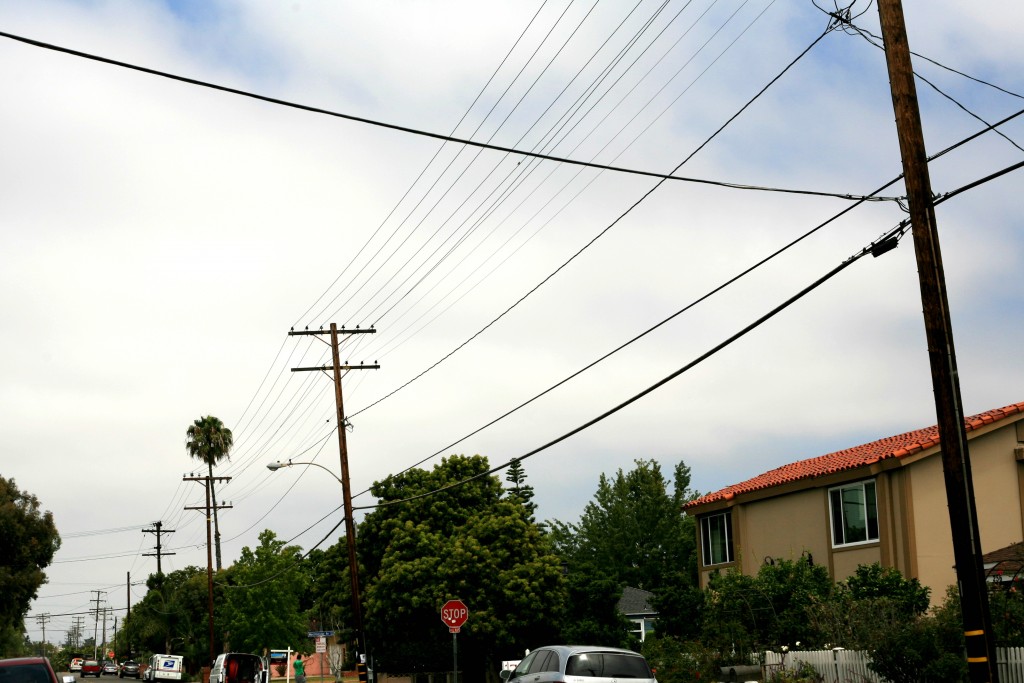
— Photo by Sara Hall ©
After several months of heated debate, one of the undergrounding petitions in Newport Heights has been withdrawn and terminated, according to the city.
“The proponents of AD 118 have withdrawn and terminated their petition. AD 118 is officially closed,” Newport Beach Deputy Public Works Director and City Engineer Mark Vukojevic wrote in an email on July 1.
Residents could request a new petition process in the future.
“It just seemed like it was in everybody’s best interest to pull the petition, cool down and look at everybody’s options moving forward,” said Newport Heights resident and undergrounding supporter, Aaron Cook.
With more than 500 properties, it might have too large a population to try and tackle, he added.
They wanted to take a step back, regroup and consider their choices for the future.
Initially, there was a lot of support, he continued. But then it became a hot topic in the neighborhood and misinformation was spread around. There are still a “substantial amount” of residents who want to go underground, he added.
On the other side of the issue, opponents were pretty happy with the news.
“I am heartened by this outcome but this is not the outcome that will benefit the residents of Newport Beach in the long run,” said Portia Weiss, Newport Heights resident and undergrounding opponent. “It is a travesty that so much time, effort and money was needed to stop this vocal minority.”
The city was complicit in enabling this process to go on for so long despite having been shown signatures opposing undergrounding that were already gathered, Weiss said.
Even more “disheartening” for Weiss is the fact that the other Newport Heights petition in District 114 is still active.
Opponents in that district have collected signatures from more than 40 percent of the residents, according to Weiss. But, there is no mandated timeframe for the proponents to collect signatures supporting the project so some may change their mind or move.
Proponents need at least 60 percent of the residents to support the project to move forward.
“We’re rooting for them,” Cook said of the proponents in District 114.
Most petitions take about one year to gather signatures and submit to the city, Vukojevic noted.
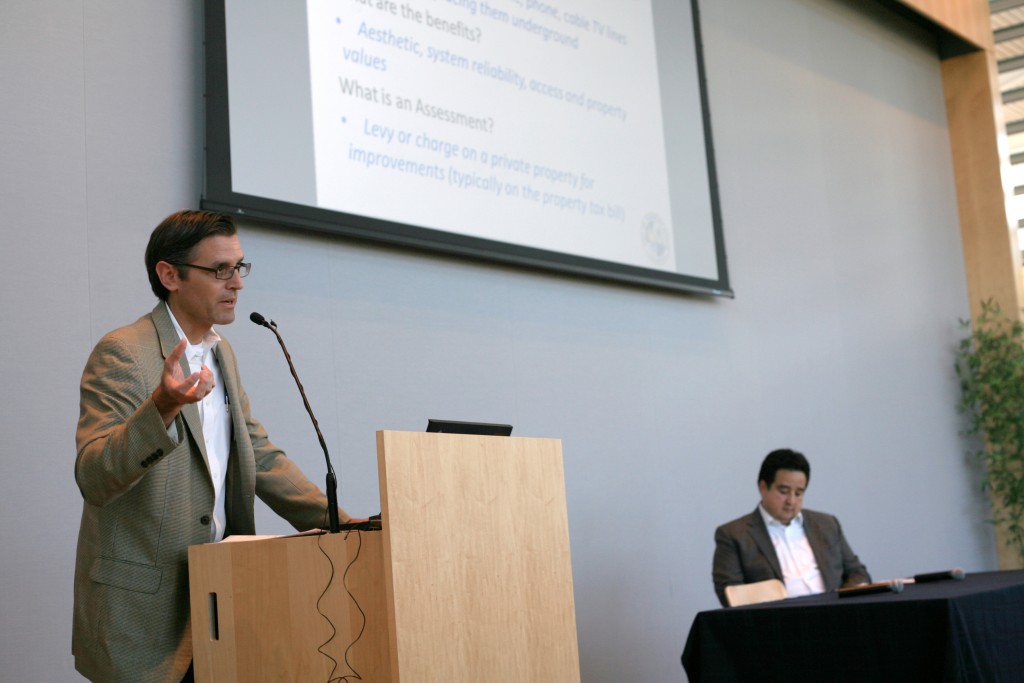
— Photo by Sara Hall ©
Vukojevic, along with Southern California Edison Regional Director of Public Affairs Larry Labrado, gave a presentation and answered questions on the issue Wednesday night for about 70 people during Speak Up Newport’s monthly meeting.
During the meeting, both explained the process, gave cost estimates and clarified the differences between Rules 20A, 20B, and 20C (the regulations that determine what type of project it is and who pays for the under grounding), and provided other information.
They both emphasized that neither the city nor Edison support or oppose the projects.
“We don’t advocate (for projects), one way or the other,” Labrado said.
It’s up to the community to decide what is best for their residents, he added.
The process starts with a request from residents, Vukojevic added, it‘s up to them.
“It’s a process driven by the community,” agreed meeting moderator and former mayor Rush Hill, who went through the process in Newport Shores several years ago.
“Southern California Edison understands the interest by communities to improve neighborhood aesthetics by placing existing overhead utilities underground,” SCE stated in an email. “The company operates primarily as an overhead electric utility, but will work with local governments and agencies when undergrounding projects are initiated and approved.”
Edison notes that there are pros and cons to placing equipment below ground and overhead.
“When providing service to our communities, safety and reliability is the primary concern for SCE,” the company explained in the email.
Prior to 1967, SCE provided electrical services primarily by means of overhead lines.
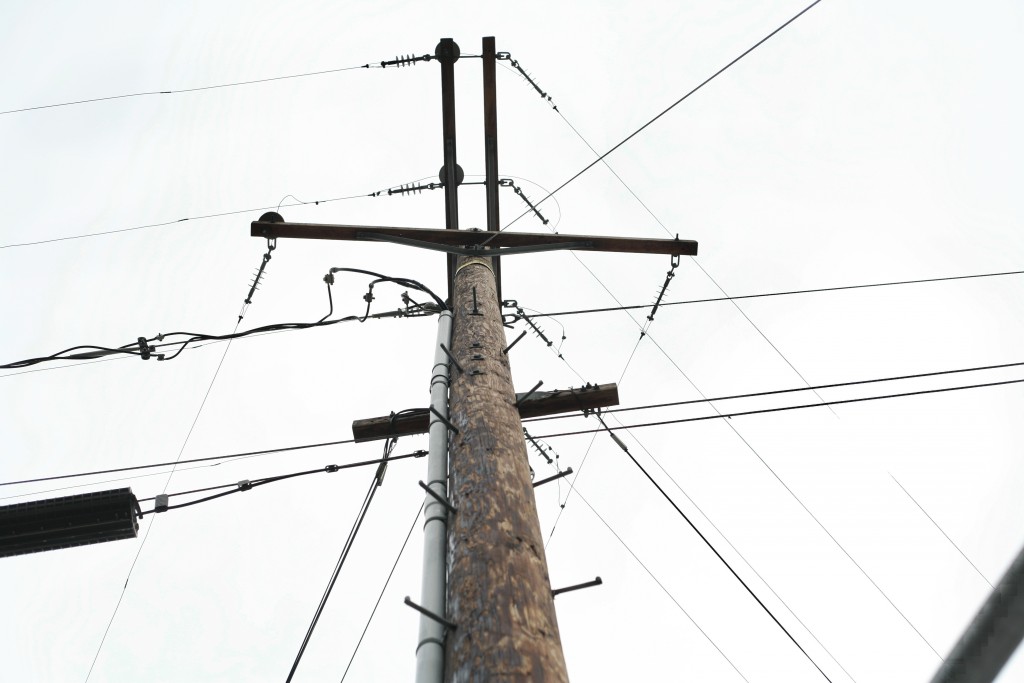
— Photo by Sara Hall ©
“As communities started to grow and started thinking about aesthetics, the (California Public Utilities) Commission came up with this program that would allow us to place utilities underground in certain circumstances,” Labrado said.
The process begins when homeowners approach the city with an interest in undergrounding utilities in their neighborhood, Vukojevic explained in an earlier interview. The interest letter includes proposed boundaries for the undergrounding.
Based on the interest letter, city staff prepare a boundary map and submits it to the appropriate utilities company for review to ensure the boundaries are logical and feasible, explained Assistant City Engineer Mike Sinacori in an earlier interview.
There needs to be an interest from 60 percent of property owners, which they express by signing a petition card in support of the idea. This process usually takes a year, Vukojevic explained. Newport Heights kicked off the process in January. State law doesn’t require a deadline for the signature gathering process.
If it gets 60 percent approval, the city has to validate the signatures. The next step is the design of the system.
Once design is approved, the project then moves on to a community vote, which needs 51 percent approval to move forward.
If the voters pass the project, it’s on to construction.
There have 119 districts go through the process and about half made it all the way through to the undergrounding effort, Sinacori said.
In an email, Weiss provided some suggestions for how the city should change the process, including creating a study group to clarify and update the ordinance governing the process, increasing the number of homeowners required to formally send a request letter, changing the language on the petition postcards, setting a time limit, raising the threshold to move past the petition gathering phase to 70 percent, and more.
Another major concern for residents is the cost.
Undergrounding is expensive, Labrado noted.
Projects usually cost roughly $1.5 to $2.5 million per mile for the smaller wires, Labrado said. It’s usually $3.5 to $5.5 million per mile for the large wires. These are very rough, broad estimates, Labrado emphasized.
The Newport Heights project was estimated to cost $10.4 million total.
That means an average size lot will be about $20,000, Sinacori said. But it really depends on the assessment of the property. Each project is unique, Labrado added.
There are two options to pay. About a quarter of residents usually choose the 30-day cash payment option. For the remaining residents, bonds are sold. This option allows residents to pay over a 15-year financing period as an assessment placed on the property tax bill. During that time, a lien will be placed on the property until the bond amount is paid in full. Bonds incur a finance charge.
The other cost residents may or may not have is connecting to the conduit. There are a lot of properties that have already put in the conduit as a part of projects they’ve worked on previously in their house, Vukojevic added. If they have done it, there is no additional cost; if they haven’t done it, the cost will range from about $1,000 to $4,000.
The alleyway project that’s scheduled for Newport Heights could help lessen the overall cost, Vukojevic confirmed. They could do certain construction work for both projects at the same time.
The cost, which could range from $10,000 to $25,000, might be feasible for some, and even more so using the financing option, but for others, it would be difficult to manage, as some residents have noted.
“It’s all about cost,” said Jerry Grant, 74, who has lived in his Newport Heights home since 1968.
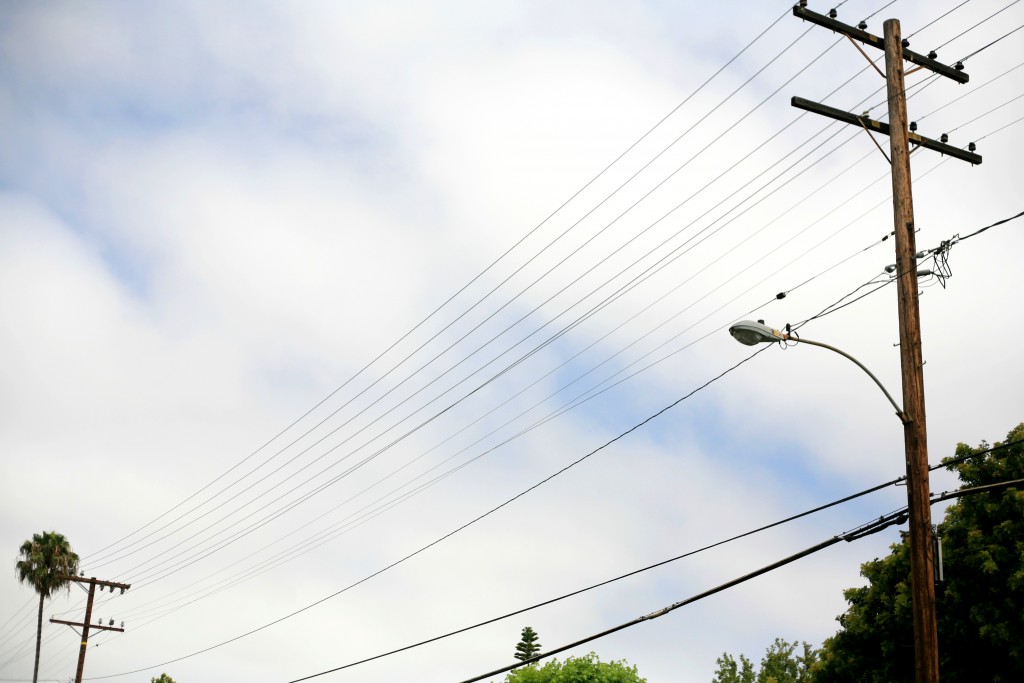
— Photo by Sara Hall ©
“Sure, all neighborhoods look better with the utilities underground, but it‘s the cost” Grant said. “The people in favor of it apparently have the money.”
“(It’s about) not having to pay for something that’s really not needed,” Grant explained. “We have safe and reliable service right now, (why change?)”
Supporters argue that if it’s not done now, it will only become more costly.
“I don’t think it’s ever going to be less expensive than it is now,” Cook said.
It may not happen right now, but Cook believes it will at some point in the future.
“I’m convinced and fairly confident that there will be some form of undergrounding in Newport Heights in the near future,” Cook said.
There has also been some confusion over the 20A, 20B and 20C rules.
The 20A projects refers to large, public streets and major roadways, Vukojevic explained.
“It doesn’t apply to residential neighborhoods,” he said.
“When you think about Rule 20A programs, think about your big thoroughfares,” Labrado said.
Rule 20B enables a property owners (who do not qualify for 20A) to form an underground utility assessment district, which is what Newport Heights and other neighborhoods fall under. For Rule 20B projects, some are paid by cities and others are initiated by local neighborhoods, Labrado said. Projects go forward only after a local vote to establish an assessment district, he added.
Rule 20C is for property owners that don’t qualify for 20A or 20B. Rule 20C applies to individual owners who want to pay for the entire project, from start to end, Labrado explained. They are “spot projects” and pretty rare and pretty expensive, he added. They are usually small projects with very few property owners, Vukojevic said. This rule is typically used by developers, Vukojevic explained earlier.
They also discussed a few other concerns residents have raised, including reliability and safety.
“Things will fail from time to time,” Labrado said. “It will happen above ground or below ground.”
It will take longer to find and repair a problem underground, he noted. Repairing it also requires two workers, for safety reasons, Labrado added.
“Edison is a pretty reliable company, whether it’s above ground or below ground,” Sinacori said earlier.
Also, larger poles will likely be installed soon, Cook noted. While there is no official plan to replace poles, Labrado said, they are constantly reviewing and updating as needed. Many areas in Newport Beach, including Newport Heights, still use the old 4-Kv system, Vukojevic explained. Edison is going through and updating them to the now standard 12-Kv system, he said.
“In doing that, that leads to new poles, bigger poles, bugger wires and so on,” Vukojevic said.
For some residents, it can be a difficult process. In Newport Heights, both sides of the issue are passionate. The project has split up friendships and divided neighbors.
“The conversation is heated,“ Cook said.
A lot of neighbors have stopped talking to each other, Grant said. He hasn’t experienced it personally, but has seen it happen.
“It’s gotten pretty bitter,” Grant said.
The issue has blown up a lot bigger than it needs to be, Cook said.
For some, undergrounding is overall better for the community for a number of reasons, Cook said.
“It will improve the overall look and feel of our community,” Cook said.
For others, it’s too expensive and there are too many possible issues.
“The concerns outweigh the (potential) beauty,” Grant said.
For more information, visit newportbeachca.gov, sce.com, improvenewportheights.com for the pro undergrounding group, and noundergrounding.com for the group opposed to undergrounding.
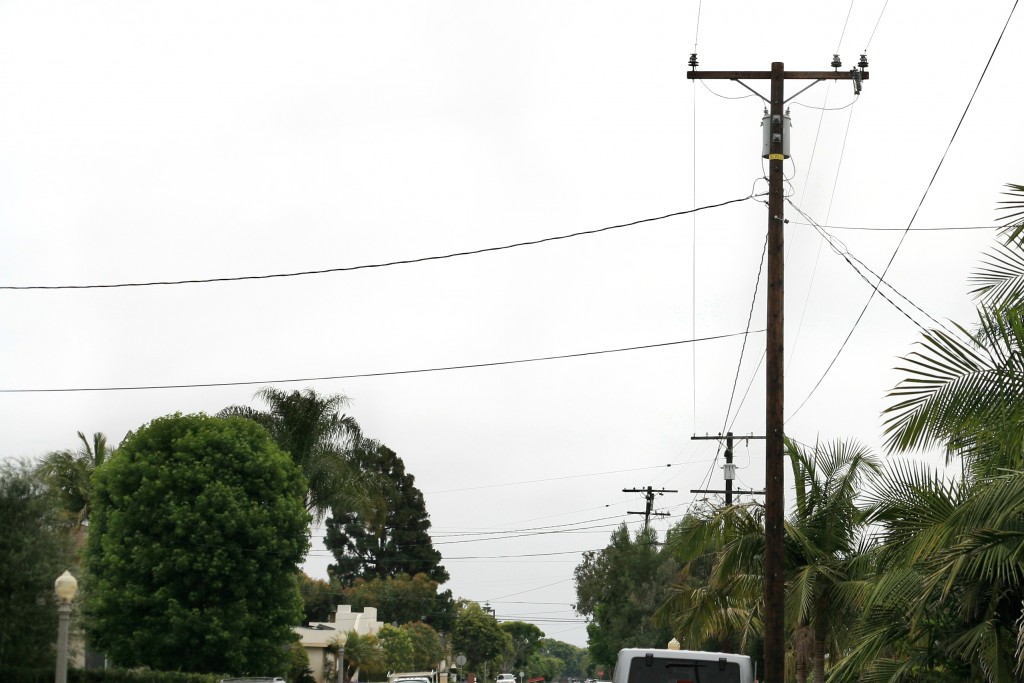





I can’t get past the city enabling the pro underground side of this issue by sending out a postcard to “request” information about the subject and calling that request a YES vote. They are raising the bar for the no underground side by declaring an “unending” time frame for the petition. And they STILL claiming that they are neutral. Give me a break.